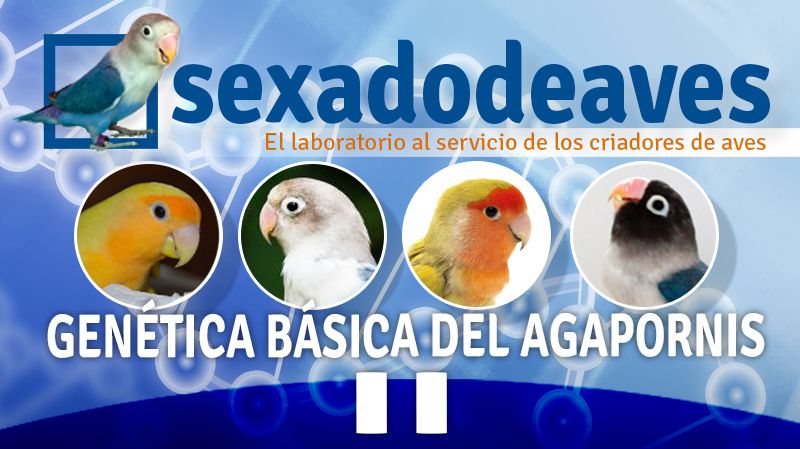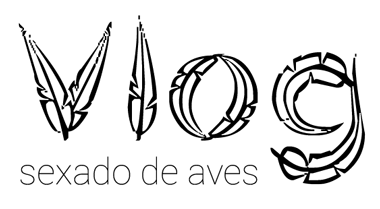Lovebirds genetics (part II)
Recessive Mutations. We already explained that this type of mutation needs to be found in both chromosomes for it to be visible. Now is when the word "carrier" comes into play. If we understand everything we

Recessive Mutations.
We already explained that this type of mutation needs to be found in both chromosomes for it to be visible. Now is when the word “carrier” comes into play. If we understand everything we have explained up to this point, we should not have any problem to understand that a specimen with a recessive mutation is the same as a DF dominant and a SF dominant is the same as to say carrier.
Thus, a bird with a recessive mutation will have this mutation completely visible and a carrier will not show the mutation. Carriers will only have the genetic information in only one chromosome pair, but they will look the same as a specimen that do not have the mutation.
This topic is so important I will explain it using an example: let’s say we have a beautiful Blue Violet male and a wonderful Opaline Lutine Orangefaced female, if they are not carriers of other mutations, the offspring will just be Green with a red mask, and that’s it. Although I try to avoid difficult terms, I find myself obliged to mention the word “codominance” when talking about the inheritance of recessive mutations.
It happens that some mutations, like Turquoise and Aqua in Roseicollis or DEC, Ino or Pastel in eye-rings lovebirds, that are placed very close along the filament of the chromosome. They are so close they “merge” together. For example, if one of the chromosomes of a Roseicollis lovebird carries a Blue mutation and the other carries a Turquoise mutation we will get an AquaTurquoise.
It happens the same with DECInos in eye-rings lovebirds. This is what is called “codominance”. In the case of dominant mutations we have used as an example two SF specimens. Now we will use the example of a mutation bird with a non mutation one in order to explain the inheritance of recessive mutations. This is a clear example to understand that although a bird has a recessive mutation if its pair does not have it their offspring will only be carriers.
Remarks on recessive mutations.
• A mutation bird or a carrier of that mutation can transmit the mutation to their descendants, but it is necessary that its pair also has the mutation or at least carries it.
• Visually, there will be no physical differences between a bird that carries the mutation and a non mutation one.
• Talking about recessive mutations, we will use the symbol / to say that a bird is a carrier. For example, if an Aqua carries Marbled we will write Aqua / Marbled.
• A bird of the green series will never carry AquaTurquoise even if one of its parents is AquaTurquoise. It will carry Aqua or Turquoise.
• Two parblue series birds will never have green series babies.
• A parblue lovebird with a couple of the green series being non carrier will always have babies of the green series.
• Another interesting topic is that a couple of two AquaTuquoise will have AquaTurquoise, Aqua and Turquoise babies.
• A roseicollis can be parblue and CN at the same time, but CN mutation will not be visible because the parblue loses the psittacine and will not let us see the orange colour.
• A CN bird that pairs with a parbleu that is not CN nor carries it, will have green series babies and with a red mask even if the parents are orange and white masked.
• Sometimes a young bird can display that is a CN carrier by the color of its mask before its moult to become an adult.
Sex-linked recessive mutations.
To effectively analyze the inheritance of LS mutations we need to take apart males from females. In males we find a set of mutations that work exactly as if they were recessive, so everything we have explained about its heritage apply to LS, but only in the case of males. Females are different. One of the sex chromosomes is not capable of storing genetic information on mutations, so it will be the other chromosome pair the one that has the mutation. If that is the case, the female will display the sex-linked colour mutation, but if the mutation cannot be found in the chromosome the female will not display the colour nor carry it. Females will never carry a Sex-linked mutation.
Watching the charts you may have noticed that in the case of these birds the females are the ones that carry the difference in their chromosomes pair (X-Y) and not males, as it is normal case (X-X). Again we find four possibilities of heritage, and in this case it is necessary to differentiate between male and female offspring.
As an example we will use my favourite combination: Sex-linked mutation male and mutation female. The resulting offspring will be the following: XX will be males and females will be X-Y. The result will be: Males: 50% mutation and 50% carriers. Females: 50% mutation and 50% non mutation. One of the characteristics of the sex-linked mutations is that we will be able to know the sex of the offspring, this will be complete when the male has the colour mutation and the female doesn’t. In the example given, we will not know the sex of the babies, but we will have sex-linked mutation males.
This is the best combination for me. Talking about recessive mutations we mentioned the codominance, it is worth is pointing out that the codominance also exists in a sex-linked mutation combination, Cinnamon and Ino. The resulting offpring will be Cinnamon-Ino that will display colours of both mutations. There is another case in the sex-linked mutations even more complicated than the codominance, but we cannot avoid mentioning it: Ino and Pallid mutations are allelic.
That does not mean they are placed very close, as was for the codominants, but that they are exactly in the same allele or locus. Specimens with this combination are called PallidIno and in order for this to happens they must have a sex chromosome mutated in Ino and the other mutated in Pallid, that is to say that the two chromosomes of the pair must be mutated so only males can have these characteristics. Females only can have a mutated sexual chromosome, meaning that they will be or Ino or Pallid, but they can never be PallidIno.
Remarks on the Sex-linked mutations.
• If we pair up two Ino, their offspring are most likely to experience weakness so it is not advisable to have pairs in which both male and female present this mutation. The best option in order to get Ino males will be with an Ino carrier male and an Ino female.
• Another distinctive feature of Ino is that, due to their loss of eumelanin these specimens can hide other mutations as Violet, Pied or Dark Factors. This means that an Ino can be Pied, have some violet factor or have some darkness factor but we might not be able to see it.
• Opaline mutation can also hide other as Violet, and even Pallid can hide Pied.
• When a PallidIno mates with a female that is neither Pallid nor Ino, thanks that they are in the same allele they will produce females that are Ino and Pallid. In conclusion I must say that we have tried to address this topic in the easiest way possible. It will probably be very simple for experts, but very complicated for amateurs and new breeders. If that’s the case, you will need to read and re-read until you feel that it is not really that difficult. Once we acknowledge these contents we will always can deepen in the study of the genetic inheritance in a more scientific way.
Juan A. García. “Agapornis La Isla”

/Agapornis: Genét/Lovebirds genetics dna sexing.jpg)
/Agapornis: Genét/Lovebirds genetics dna sexing 1.jpg)
/Agapornis: Genét/Lovebirds genetics dna sexing 2.jpg)
/Agapornis: Genét/Lovebirds genetics dna sexing 3.jpg)
/Agapornis: Genét/Lovebirds genetics dna sexing 6.jpg)
/Agapornis: Genét/Lovebirds genetics dna sexing 4.jpg)

Ab Khan April 11, 2020
A nice comprehensive note on recessive mutations. How would you define Par blue and Euwing lovebirds? Please shed some light on this and oblige..
zaid hussain June 1, 2020
seriously very much helpfull